International Journal of Image, Graphics and Signal Processing @ijigsp
Статьи журнала - International Journal of Image, Graphics and Signal Processing
Все статьи: 1157
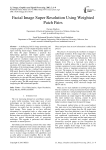
Facial Image Super Resolution Using Weighted Patch Pairs
Статья научная
A challenging field in image processing and computer graphics is to have higher frequency details by super resolving facial images. Unlike similar papers in this field, this paper introduces a practical face hallucinating approach with higher quality output images. The image reconstruction was based on a set of high and low resolution image pairs. Each image is divided into defined patches with overlapped regions. A patch from a defined location is removed from the low resolution (LR) input image and is compared with the LR patches of the training images with the same location. Each defined LR patch has a defined high resolution (HR) patch. Based on the Euclidean distance comparison, each patch of every single image in the training images database receives a specific weight. This weight is transferred to its relevant HR patch identically. The sum of the gained weights for one specific location of a patch is equal to unity. The HR output image is constructed by integrating the HR hallucinated patches.
Бесплатно
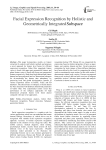
Facial expression recognition by holistic and geometrically integrated subspace
Статья научная
This paper demonstrates mainly on feature extraction by analytic and holistic methods and proposes a novel approach for feature level fusion for efficient expression recognition. Gabor filter magnitude feature vector is fused with upper part geometrical features and phase feature vector is fused with lower part geometrical features respectively. Both these high dimensional feature dataset has been projected into low dimensional subspace for de-correlating the feature data redundancy by preserving local and global discriminative features of various expression classes of JAFFE, YALE and FD databases. The effectiveness of subspace of fused dataset has been measured with different dimensional parameters of Gabor filter. The experimental results reveal that performance of the subspace approaches for high dimensional proposed feature level fused dataset compared with state of art approaches.
Бесплатно
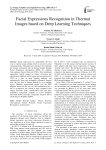
Facial expressions recognition in thermal images based on deep learning techniques
Статья научная
Facial expressions are undoubtedly the best way to express human attitude which is crucial in social communications. This paper gives attention for exploring the human sentimental state in thermal images through Facial Expression Recognition (FER) by utilizing Convolutional Neural Network (CNN). Most traditional approaches largely depend on feature extraction and classification methods with a big pre-processing level but CNN as a type of deep learning methods, can automatically learn and distinguish influential features from the raw data of images through its own multiple layers. Obtained experimental results over the IRIS database show that the use of CNN architecture has a 96.7% recognition rate which is high compared with Neural Networks (NN), Autoencoder (AE) and other traditional recognition methods as Local Standard Deviation (LSD), Principle Component Analysis (PCA) and K-Nearest Neighbor (KNN).
Бесплатно
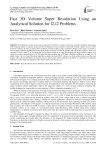
Fast 3D Volume Super Resolution Using an Analytical Solution for l2-l2 Problems
Статья научная
In Endodontics, dentists need a good visualization of dental root canals as found in Cone Beam Computed Tomography (CBCT) dental volumes to diagnose and prevent the development of some anomalies. These CBCT dental volumes, however, suffer from low resolution. In order, to enhance their resolution, we need to apply a super-resolution technique. In this paper, we propose a new 3D super resolution algorithm based on a linear model, consisting of a blurring operator and a decimation operator, which is an extension of Zhao’s work [1] in 3D, taking the low-resolution volume as an input and producing the high-resolution volume as an output. We present a generalization of the 2D Super-Resolution problem into a 3D Super- Resolution problem as we apply it to 3D dental volume. Our new Super-Resolution algorithm as applied to dental CBCT volumes is a direct method aiming to get the exact solution with a short computation time. Results show an improvement in the resolution of the CBCT in a short time in comparison with Zhao’s work, which was applied to CBCT dental volumes slice by slice, [2]
Бесплатно
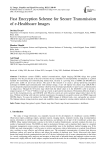
Fast Encryption Scheme for Secure Transmission of e-Healthcare Images
Статья научная
E-healthcare systems (EHSD), medical communications, digital imaging (DICOM) things have gained popularity over the past decade as they have become the top contenders for interoperability and adoption as a global standard for transmitting and communicating medical data. Security is a growing issue as EHSD and DICOM have grown more usable on any-to-any devices. The goal of this research is to create a privacy-preserving encryption technique for EHSD rapid communication with minimal storage. A new 2D logistic-sine chaotic map (2DLSCM) is used to design the proposed encryption method, which has been developed specifically for peer-to-peer communications via unique keys. Through the 3D Lorenz map which feeds the initial values to it, the 2DLSCM is able to provide a unique keyspace of 2544 bits (2^544bits) in each go of peer-to-peer paired transmission. Permutation-diffusion design is used in the encryption process, and 2DLSCM with 3DLorenz system are used to generate unique initial values for the keys. Without interfering with real-time medical transmission, the approach can quickly encrypt any EHSD image and DICOM objects. To assess the method, five distinct EHSD images of different kinds, sizes, and quality are selected. The findings indicate strong protection, speed, and scalability when compared to existing similar methods in literature.
Бесплатно
Статья научная
In the present day real time applications of visual object tracking in surveillance, it has become extremely complex, time consuming and tricky to do the tracking when there are occlusions are present for small duration or for longer time and also when it is done in outdoor environments. In these conditions, the target to be tracked can be lost for few seconds and that should be tracked as soon as possible. As from the literature it is observed that particle filter can be able to track the target robustly in different kinds of background conditions, and it’s robust to partial occlusion. However, this tracking cannot recover from large proportion of occlusion and complete occlusion, to avoid this condition, we proposed two new algorithms (modified kalman and modified particle filter) for fast tracking of objects in the presence of occlusions. We considered the complete occlusion of tracking object and the main objective is how fast the system is able to track the object after the occlusion is crossed. From the experimental results, it is observed that the proposed algorithms have shown good improvement in results compared to the traditional methods.
Бесплатно
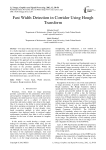
Fast Width Detection in Corridor Using Hough Transform
Статья научная
For many robotics and smart car applications it is vitally important to calculate the width. The present paper proposes a new approach for finding the width of a corridor within a constructed image frame that would keep a robot on a safe track away from walls. The main advantage of this approach is less computation time and hence faster response for path recognition. In this new approach, the Hugh Transform technique is also used as the basis of the provided algorithm. Within the determination of corridor width, in order to avoid the accident in the future researches, some approaches such as identify open space, modeling and reconstruction of three-dimensional space, can also be used.
Бесплатно
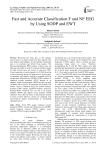
Fast and Accurate Classification F and NF EEG by Using SODP and EWT
Статья научная
Removing the brain part, as the epilepsy source attack, is a surgery solution for those patients who have drug resistant epilepsy. So, the epilepsy localization area is an essential step before brain surgery. The Electroencephalogram (EEG) signals of these areas are different and called as focal (F) whereas the EEG signals of other normal areas are known as non-focal (NF). Visual inspection of multi-channels for F EEG detection is time-consuming along with human error. In this paper, an automatic and adaptive method is proposed based on second order difference plot (SODP) of EEG rhythms in empirical wavelet transform (EWT) domain as an adaptive signal decomposition. SODP provides the data variability rate or gives a 2D projection for rhythms. The feature vector is obtained using the central tendency measure (CTM). Finally, significant features, chosen by Kruskal–Wallis statistical test, are fed to K nearest neighbor (KNN) and support vector machine (SVM) classifiers. The achieved results of the proposed method in terms of three objective criteria are compared with state-of-the-art papers demonstrating an outstanding algorithm here in.
Бесплатно
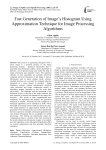
Fast generation of image’s histogram using approximation technique for image processing algorithms
Статья научная
The process of generating histogram from a given image is a common practice in the image processing domain. Statistical information that is generated using histograms enables various algorithms to perform a lot of pre-processing task within the field of image processing and computer vision. The statistical subtasks of most algorithms are normally effectively computed when the histogram of the image is known. Information such as mean, median, mode, variance, standard deviation, etc. can easily be computed when the histogram of a given dataset is provided. Image brightness, entropy, contrast enhancement, threshold value estimation and image compression models or algorithms employ histogram to get the work done successfully. The challenge with the generation of the histogram is that, as the size of the image increases, the time expected to traverse all elements in the image also increases. This results in high computational time complexity for algorithms that employs the generation histogram as subtask. Generally the time complexity of histogram algorithms can be estimated as O(N2) where the height of the image and its width are almost the same. This paper proposes an approximated method for the generation of the histogram that can reduce significantly the time expected to complete a histogram generation and also produce histograms that are acceptable for further processing. The method can theoretically reduce the computational time to a fraction of the time expected by the actual method and still generate outputs of acceptable level for algorithms such as Histogram Equalization (HE) for contrast enhancement and Otsu automatic threshold estimation.
Бесплатно

Feature Based Image Mosaic Using Steerable Filters and Harris Corner Detector
Статья научная
Image mosaic is to be combine several views of a scene in to single wide angle view. This paper proposes the feature based image mosaic approach. The mosaic image system includes feature point detection, feature point descriptor extraction and matching. A RANSAC algorithm is applied to eliminate number of mismatches and obtain transformation matrix between the images. The input image is transformed with the correct mapping model for image stitching and same is estimated. In this paper, feature points are detected using steerable filters and Harris, and compared with traditional Harris, KLT, and FAST corner detectors.
Бесплатно
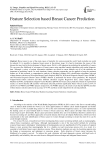
Feature Selection based Breast Cancer Prediction
Статья научная
Breast cancer is one of the main causes of mortality for women around the world. Such mortality rate could be reduced if it is possible to diagnose breast cancer at the primary stage. It is hard to determine the causes of this disease that may lead to the development of breast cancer. But it is still important in predicting the probability of cancer. We can assess the likelihood of occurrence of breast cancer using machine learning algorithms and routine diagnosis data. Although a variety of patient information attributes are stored in cancer datasets not all of the attributes are important in predicting cancer. In such situations, feature selection approaches can be applied to keep the pertinent feature set. In this research, a comprehensive analysis of Machine Learning (ML) classification algorithms with and without feature selection on Wisconsin Breast Cancer Original (WBCO), Wisconsin Diagnosis Breast Cancer (WDBC), and Wisconsin Prognosis Breast Cancer (WPBC) datasets is performed for breast cancer prediction. We employed wrapper-based feature selection and three different classifiers Logistic Regression (LR), Linear Support Vector Machine (LSVM), and Quadratic Support Vector Machine (QSVM) for breast cancer prediction. Based on experimental results, it is shown that the LR classifier with feature selection performs significantly better with an accuracy of 97.1% and 83.5% on WBCO and WPBC datasets respectively. On WDBC datasets, the result reveals that the QSVM classifier without feature selection achieved an accuracy of 97.9% and these results outperform the existing methods.
Бесплатно
Feature Tracking and Synchronous Scene Generation with a Single Camera
Статья научная
This paper shows a method of tracking feature points to update camera pose and generating a synchronous map for AR (Augmented Reality) system. Firstly we select the ORB (Oriented FAST and Rotated BRIEF) [1] detection algorithm to detect the feature points which have depth information to be markers, and we use the LK (Lucas-Kanade) optical flow [2] algorithm to track four of them. Then we compute the rotation and translation of the moving camera by relationship matrix between 2D image coordinate and 3D world coordinate, and then we update the camera pose. Last we generate the map, and we draw some AR objects on it. If the feature points are missing, we can compute the same world coordinate as the one before missing to recover tracking by using new corresponding 2D/3D feature points and camera poses at that time. There are three novelties of this study: an improved ORB detection, which can obtain depth information, a rapid update of camera pose, and tracking recovery. Referring to the PTAM (Parallel Tracking and Mapping) [3], we also divide the process into two parallel sub-processes: Detecting and Tracking (including recovery when necessary) the feature points and updating the camera pose is one thread. Generating the map and drawing some objects is another thread. This parallel method can save time for the AR system and make the process work in real-time.
Бесплатно
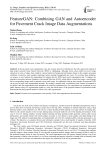
FeatureGAN: Combining GAN and Autoencoder for Pavement Crack Image Data Augmentations
Статья научная
In the pavement crack segmentation task, the accurate pixel-level labeling required in the fully supervised training of deep neural networks (DNN) is challenging. Although cracks often exhibit low-level image characters in terms of edges, there might be various high-level background information based on the complex pavement conditions. In practice, crack samples containing various semantic backgrounds are scarce. To overcome these problems, we propose a novel method for augmenting the training data for DNN based crack segmentation task. It employs the generative adversarial network (GAN), which utilizes a crack-free image, a crack image, and a corresponding image mask to generate a new crack image. In combination with an auto-encoder, the proposed GAN can be used to train crack segmentation networks. By creating a manual mask, no additional crack images are required to be labeled, and data augmentation and annotation are achieved simultaneously. Our experiments are conducted on two public datasets using five segmentation models of different sizes to verify the effectiveness of the proposed method. Experimental results demonstrate that the proposed method is effective for crack segmentation.
Бесплатно
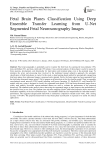
Статья научная
Fetal neurosonography is potentially used to examine the fetal brain by scanning the trans-thalamic (TT), trans-cerebellum (TC), and trans-ventricular (TV) planes. Cross-sectional analysis of these planes is useful to assess the brain anatomy, development, and abnormality for intervention and treatment plans even at the postnatal stage. To minimize the errors and processing time involved in the traditional manual subjective approach, the automatic classification of fetal brain planes is crucial. In this study, a deep learning-based method for automatically categorizing fetal brain planes from ultrasound images is proposed and evaluated. Firstly, the brain region has been segmented from the fetal brain ultrasound images using U-Net to prepare an efficient data set for the classifier model. Then, an ensemble convolutional neural network (CNN) model including well-known Inception V3, ResNet50-V2, and DenseNet-201 models with max voting is designed to classify the segmented brain planes. 2019 fetal brain ultrasound images from a widely used publicly accessible experts-annotated dataset are used to evaluate the performance of the proposed framework. The obtained results analysis shows that using the segmented images as input improves the performance of the classifier from its raw form. The gradient class activation mapping (Grad-CAM) based inspection shows noteworthy localization capability of the last convolution layer. The ensemble model has also outperformed its individual model’s performance. The suggested categorization framework is satisfactory compared to related recent works, with a testing accuracy of 97.68%. The proposed framework for fetal brain plane classification is expected to be useful for clinical applications.
Бесплатно

Fig (Ficus Carica L.) Identification Based on Mutual Information and Neural Networks
Статья научная
The process of recognition and identification of plant species is very time-consuming as it has been mainly carried out by botanists. The focus of computerized living plant's identification is on stable feature's extraction of plants. Leaf-based features are preferred over fruits, also the long period of its existence than fruits. In this preliminary study, we study and propose neural networks and Mutual information for identification of two, three Fig cultivars (Ficus Carica L.) in Syria region. The identification depends on image features of Fig tree leaves. A feature extractor is designed based on Mutual Information computation. The Neural Networks is used with two hidden layers and one output layer with 3 nodes that correspond to varieties (classes) of FIG leaves. The proposal technique is a tester on a database of 84 images leaves with 28 images for each variety (class). The result shows that our technique is promising, where the recognition rates 100%, and 92% for the training and testing respectively for the two cultivars with 100% and 90 for the three cultivars. The preliminary results obtained indicated the technical feasibility of the proposed method, which will be applied for more than 80 varieties existent in Syria.
Бесплатно
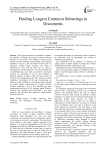
Finding Longest Common Substrings in Documents
Статья научная
This paper introduces an algorithm to address the problem of finding the longest common substring between two documents. This problem is known as the longest common substring (LCS) problem. The proposed algorithm is based on the convolution between the two sequences (named major sequence (X) which is represented as array and the minor one (Y) which is represented as circular linked list. An array of linked lists is established and a new node is created for each match between two substrings. If two or more matches in different locations in string Y share the same location in string X, the corresponding nodes will construct a unique linked-list. Accordingly, by the end of processing, we obtain a group of linked-lists containing nodes arranged in certain manner representing all possible matches between sequences X and Y. The algorithm has been implemented and tested in C# language under Windows platform. The obtained results presented a very good speedups and indicated that impressive improvements had been achieved.
Бесплатно
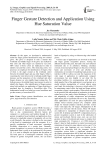
Finger gesture detection and application using hue saturation value
Статья научная
In this paper, we developed a mathematical model for finger gesture identification using two colored glove. The glove is designed in such a manner that wristband and middle finger of the glove are marked by blue color and other fingers are marked by red color. HSV values of those colors are implicated in order to identify red and blue colors. After detecting colors, two processes are employed for identification of fingers. One of them is the angle created at the wristband center between the middle finger and any other fingers. Other is examining the ratio between the wristband-middle finger distance and the projection of the wristband and other fingers distance on wrist-middle finger joining line. For both processes, the middle finger must present in order to identify the fingers. After identification of fingers gesture using both methods, an application of finger detection is presented here by changing a PowerPoint slide. This mathematical model was tested on several conditions and got the accuracy of more than 82%.
Бесплатно
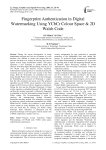
Fingerprint Authentication in Digital Watermarking Using YCbCr Colour Space & 2D Walsh Code
Статья научная
During the recent development in image manipulating software and vast use of Internet, it is now becomes very difficult to protect the images that are precious and need to be secured so that they will survive against several image modification attacks. This paper represents a new technique to produce robust and efficient Twin blind digital Watermarking with the use of 2-D Walsh code and Discrete Cosine transform. Authentication matching process is introduced during the extraction process to provide extra security to the Host image. Both the Watermarks are embedded into host image through Walsh Code conversion. In this technique, the Embedding and extraction of Watermark is simpler than the other transform previously used. The proposed algorithm uses the YCbCr colour elements of the colour images in DCT province with low frequency components. During the first step the Principal Watermark i.e Hand written signature is embedded through 2-D Walsh coding and then the resultant watermark i.e Biometric fingerprint is embedded to the first Watermarked image through 2-D Walsh coding. The De-watermarking is dawn by checking the Authentication through Biometric fingerprint matching method. The technique is accessed by analyzing various performance parameters like SSIM, PSNR and NC. Further, the evaluation is made through various attacks by using StirMark tool. It was observed from the result that, by utilizing 2-D Walsh coding technique, better robustness is maintained and the proposed technique survived against various attacks such as JPEG compression, median, noise etc.
Бесплатно
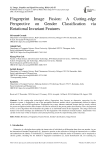
Статья научная
In this cutting-edge technological milieu, fingerprints have become an alternative expression for the biometrics system. A fingerprint is one of the perceptible biometric modals which is predominantly utilized in almost all the security, and real-life applications. Fingerprints have many inherent rotational features that are mostly utilized for person recognition besides these features can also be utilized for the person gender classification. Thus, the proposed work is a novel algorithm which identifies the gender of an individual based on the fingerprint. The image fusion and feature level fusion technique are deliberated over the fingerprints with rotational invariant features. Experiments were carried on four state-of-the-art datasets and realized promising results by outperforming earlier outcomes.
Бесплатно
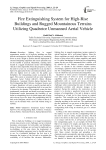
Статья научная
Nowadays, fighting fires in rugged mountainous terrains or in high-rise buildings are both difficult and dangerous. High-rise buildings are containing floors at such a height or position that the deployment of external firefighting equipment and rescue operations may not be feasible or practical. Meanwhile, reaching farms located in a rugged mountainous terrain with firefighting vehicles is often impossible. From this perspective, to meet the need for a fast way to extinguish fire in an area that is hard to be approached by the conventional methods, and to offer the highest level of safety for the public and firefighters; fire extinguishing system is proposed in this paper. The system is structured with six units: Quadrotor Unmanned Aerial Vehicle (QUAV), Robot (Release Mechanism), Automatic Electric_Spring Operated Gun, Fire Extinguishing Ball, Collision Avoidance System, and a Camera. Quadrotor will carry a specific payload and be capable of throwing an extinguishing balls in an area that is chosen by the operator. The proposed system has been implemented, constructed, and tested in an actual scenarios. Experimental results demonstrate the feasibility of our drone in extinguishing fire in its initial stages and of being safe to hover over a fire, drop a fire extinguishing ball, fly back to the firefighter, and hover at 2.5 meters in the air so that it can be reloaded with a new ball without losing its stability.
Бесплатно

